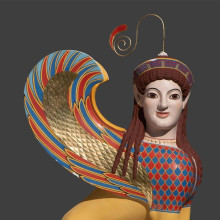In 2021, The Metropolitan Museum’s Imaging Department, under the direction of Scott Geffert, successfully measured the sphinx of the Greek funerary monument of Megakles in three dimensions with great detail using photogrammetry. This data was processed by Ralf Deuke in Munich and passed on to the company Voxeljet in southern Germany, where the sphinx was built in two components made of Plexiglas powder (polymethylmetacrylate) in their 3D printers. Ulrike Koch-Brinkmann carefully added to this copy at selected minor breakage points and then covered it with several superfine layers of marble stucco and smoothed it. The result of this collaborative effort, a likely reconstruction of the sphinx in its original form and color, is on view in the special exhibition “Chroma: Ancient Sculpture in Color”.
To recreate the armature of the feather patterns on the breast and wings of the sphinx, as well as the application of the colors themselves, Ulrike Koch-Brinkmann and Vinzenz Brinkmann’s team relied on rich scientific findings by The Met scientists, conservators, and Imaging team, including multispectral photographs by Dorothy Abramitis, as well as ultraviolet-visible absorption spectroscopy (UV-VIS) by Heinrich Piening, which were supplemented by further photographs in ultraviolet (UVL) and infrared (VIL) fluorescence and false color (iDStretch app) captured by Vinzenz Brinkmann.
Since the early 1980s, Vinzenz Brinkmann has examined numerous Archaic-period marble sphinxes in Greek museums—including the Acropolis Museum of Athens, the National Archaeological Museum of Athens, and the Corinth Archaeological Museum—with the help of multispectral photography, microscopy, and raking light, as part of a larger research project. In addition, the Liebieghaus team also investigated representations of the sphinx in other visual media dating to the sixth century B.C. This extensive analysis of archaeological and art-historical comparanda offered a significant data pool that complemented the scientific and photo-technical examinations of the original, enabling a more complete reconstruction.
This article is an abridged version of the original article by Vinzenz Brinkmann, Ulrike Koch-Brinkmann and Heinrich Piening that appeared in the online publication "Perspectives" on 12 August, 2022.
Read the full article here.









